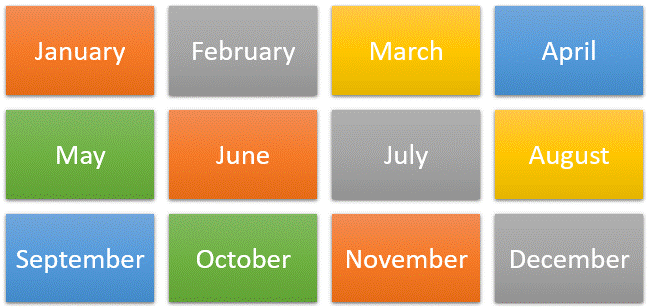12 Month Name – Month Name In English And Hindi
Month Name
The knowledge of month names in English not only helps scheduling and planning but also walk through traditions, festivals and climatic variations that characterize through out the year. Months are important for how we structure our lives and plan events. Whether it’s making appointments, organizing activities or simply keeping track of time, it’s crucial to know the names and features of the months.
In this article 12 Month Name – Month Name In English and Hindi, we’ll explore the twelve months of the year, looking at their names, length and unique characteristics. We’ll provide insights into the English and Hindi names of the months, how many days each month has and the cultural importance tied to them.
12 Month Calendar
One of the earliest known calendars, the lunar calendar, influenced the naming and structuring of the months. Ancient cultures often tied the months to lunar phases, agricultural cycles and religious observances.
The Roman calendar, an early predecessor to the Gregorian calendar we use today, played a pivotal role in shaping the months. The Roman calendar originally had ten months, with the months of January and February added later. The addition of these two months brought the total to 12, aligning more closely with lunar and solar cycles.
The Gregorian calendar, the most widely used calendar globally divides the year into twelve months, each representing a specific period of time. A year is the time it takes for Earth to complete one orbit around the sun. The division into 12 months corresponds roughly to the lunar month and helps align the calendar with natural phenomena. These months have names rooted in ancient languages and cultures, contributing to how we organize our daily lives. Many of these names have connections to lunar cycles, showing the link between our calendar and the movements of celestial bodies.
12 Month Name in English
The Gregorian calendar, with its twelve months, marks beginnings of year with January, laden with resolutions and promise and ending on to the festive cheer of December. Below is list of 12 month name in English.
| Sequence | Month Name In English | Number of Days |
|---|---|---|
| 1 | January | 31 |
| 2 | February | 28* (exception for leap year with number of days 29) |
| 3 | March | 31 |
| 4 | April | 30 |
| 5 | May | 31 |
| 6 | June | 30 |
| 7 | July | 31 |
| 8 | August | 31 |
| 9 | September | 30 |
| 10 | October | 31 |
| 11 | November | 30 |
| 12 | December | 31 |
12 Month Name In Hindi
While the English names have their roots in various ancient languages and cultures, the Hindi names, being a part of the Indian cultural and linguistic landscape, reflect a distinct regional flavor. Let’s have look at the month name in hindi.
| Sequence | Month Name In Hindi |
|---|---|
| 1 | जनवरी |
| 2 | फ़रवरी |
| 3 | मार्च |
| 4 | अप्रैल |
| 5 | मई |
| 6 | जून |
| 7 | जुलाई |
| 8 | अगस्त |
| 9 | सितंबर |
| 10 | अक्टूबर |
| 11 | नवंबर |
| 12 | दिसंबर |
12 Month Name In English Important Events
With twelve months in a year, each carrying its own linguistic and regional flavor, the Hindi names of the months encapsulate a rich diversity of traditions, festivals and climate. Let’s explore significance and essence of each month.
| Month Name | Significance | Birthday |
|---|---|---|
| January | Marks the beginning of the year, New Year’s Day celebrations. The first month of the year, January, is characterized by winter in the Northern Hemisphere. | Netaji Subhas Chandra Bose (23rd January) |
| February | Shortest month of the year. In leap years, the month has 29 days instead of 28 days. it witnesses varying weather from mild to warmer tropical conditions. | Sarojini Naidu (13th February) |
| March | March signifies the approach of spring, warmer temperatures and the celebration of Holi | Ram Manohar Lohia (23rd March) |
| April | April brings the end of spring and the onset of warmer days. Festivals like Baisakhi and Easter are celebrated. | Dr. B.R. Ambedkar (14th April) |
| May | May is characterized by spring in the Northern Hemisphere and the height of summer in the Southern Hemisphere. | Rabindranath Tagore (7th May) |
| June | June marks the beginning of the monsoon season in India, with heavy rainfall in coastal regions. | Rajendra Prasad (3rd July) |
| July | July sees the monsoon advancing across India, providing relief from the heat. Humidity increases with occasional rainfall. | Bal Gangadhar Tilak (23rd July) |
| August | August is characterized by Independence Day celebrations in India and consistent warm weather with occasional rainfall. | Sri Aurobindo (15th August |
| September | September marks the end of the monsoon season in India, leading to drier and sunnier weather. | Bhagat Singh (27th September) |
| October | October in India welcomes warm and sunny weather as the monsoon concludes. | Mahatma Gandhi (2nd October) |
| November | November brings cooler temperatures, officially concluding the monsoon season. | Jawaharlal Nehru (14th November) |
| December | December experiences chilly weather, especially in the northern Himalayas and is globally celebrated as Christmas. | Rajendra Prasad (3rd December) |
Conclusion
As we traverse the months with this article 12 Month Name – Month Name In English and Hindi, each one unfolds a unique flavor of festivals, historical events and nature. Whether it’s the vibrant colors of Holi in March, the patriotic fervor of Independence Day in August or the joyous celebrations of Diwali in November, each month resonates with cultural significance. As we move through the ever-turning wheel of time, may we continue to cherish and celebrate the diversity in theese twelve months.
Frequently Asked Questions
Q1. How many months are there in a year?
There are 12 months in a year.
Q2. What are the names of the 12 months in English?
The 12 months in English are January, February, March, April, May, June, July, August, September, October, November and December.
Q3. Provide the names of the 12 months in Hindi?
12 month in Hindi are जनवरी (January), फरवरी (February), मार्च (March), अप्रैल (April), मई (May), जून (June), जुलाई (July), अगस्त (August), सितम्बर (September), अक्टूबर (October), नवम्बर (November) and दिसम्बर (December).
Q4. How many days are there in each month?
The number of days varies for each month. For example, January, March, May, July, August, October, December has 31 days and April, June, September, November has 30 days. February has 28 days in a common year and 29 days in a leap year.
Q5. What is the Gregorian Calendar?
The Gregorian Calendar is a widely used solar-based calendar that divides the year into 12 months. It is the calendar system most commonly used today.
Q6. Which month features the shortest day of the year?
December features the shortest day of the year, typically around the 20th or 21st.


